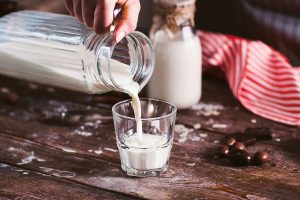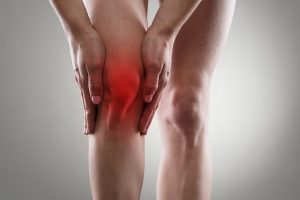Some drink milk, others are lactose intolerant; this is the fact about drinking milk.
For a long time the dairy marketing board advertised with the slogan: “Got milk?”. But dairy milk consumption has declined over the past decades.
Why this is has been reviewed in this article. I like to review the problem of lactose intolerance, milk as a source of calcium to prevent osteoporosis and offer alternatives to milk consumption.
Lactose intolerance
Milk cows have been around in Europe for about 6000 years. But not everybody can tolerate milk products. Most of the Europeans, North Americans and Australians have adjusted the digestive enzymes in their duodenum to produce enzymes, called lactase that digest milk sugar (lactose) into glucose and galactose. But up to 75% of the world population (Africa, South America, Asia) is lactase deficient; they cannot tolerate dairy products. They get abdominal cramping, intestinal gas, bloating, diarrhea, nausea and vomiting from drinking a glass of dairy milk. This link explains why goat milk is better than cow’s milk for those who cannot tolerate cow’s milk.
It is also interesting that many people who are lactase deficient can tolerate cheeses, yogurt and other fermented milk products as the fermenting bacteria have digested the lactose.
Other problems with dairy products
Problems with mass production of dairy items are the following:
- Concentrated Animal Feeding Operations (CAFO) are responsible for the majority of milk products on grocery market shelves. This means that the animals are fed unnatural corn, which leads to deficiencies and omega-6 fatty acids in the milk products.
- Herds of animals receive antibiotics to prevent infections.
- Farmers are administering bovine growth hormone (bST, bovine somatotropin) to stimulate more milk production. The antibiotics lead to superbugs in humans, the bST may be causing autoimmune diseases and breast cancer in humans. The healthiest milk is milk from grass-fed cows. It is high in omega-3 fatty acids. All of the milk products derived from this type of milk are also healthy.
Milk as a source of calcium
One key advertising slogan of the dairy industry used to be that milk would be such a good source of calcium, which would prevent osteoporosis. But milk also has a lot of animal protein in it, which acidifies blood. This means that the kidneys use calcium to neutralize acidic blood and excrete calcium. The net result is that there is more calcium leaving the body. Some of the calcium from the bone serves to keep the balance between acidity and alkalinity neutral.
This 12 year long Harvard Nurses’ Health Study involving 77, 761 women between the ages of 34 to 59 showed that a higher consumption of milk did not protect against hip and wrist fractures.
The myth that full fat milk causes heart attacks and strokes
There is another myth floating around, namely that full fat milk would be bad for the heart because of increased saturated fatty acids. But an Australian study showed that full fat milk is healthier for you than milk with less fat.
After 14.4 years of follow-up the group that consumed the most milk compared to the lowest fat intake group had a 69% lower death rate from cardiovascular disease!
A 2016 study showed that consumption of plain yogurt was associated with better health outcomes on the long term. Be more concerned about the sugar content than the fat content of yogurt!
Prevention of osteoporosis
For years numerous sources have indoctrinated us to accept a false concept. It is the concept of increasing milk consumption (“Got milk?”) for increased calcium intake and possible osteoporosis prevention. The sales mantra went like this: Milk-calcium-osteoporosis prevention. Now we know the real truth. Milk provides protein and calcium. But absorption of calcium is poor and the acidified blood is alkalinized through calcium from milk and from the bone leaking calcium into the blood and into the urine. The end result is a net loss of calcium from the bone, as it is more important to the body to keep the blood’s acid/base stable than to increase the calcium level in the bone. Sadly all the high consumers of milk from the Harvard Nurses’ Health Study ended up having fractures from osteoporotic bones.
Prevention of osteoporosis requires intake of vitamin D3, vitamin K2 and calcium (supplement or diet) as I have reviewed in this blog. In addition regular exercise is also very beneficial as is bioidentical sex-hormone replacement. It is interesting that a large clinical trial that I mentioned in this blog showed after 7 years that there were 35% to 38% less fractures of the hip than in the placebo group. Vitamin K2 is essential to keep calcium in the bones and to keep calcium out of the blood vessel walls. Vitamin D3 is important for calcium absorption through the gut wall and to deposit calcium into bone. Without all of these ingredients it is not possible to prevent osteoporosis.
Alternatives to cow’s milk consumption
- One obvious step is to replace cow’s milk by goat milk. As you can see from this link, there are many advantages to goat milk. What I find important is the fact that those with lactase deficiency often can tolerate goat milk while they would otherwise react to cow’s milk. There are also many goat milk products like cheese and yogurt, all of which are very healthy. They do not contain any antibiotics or bovine growth hormone (bST), the use of which is confined to cows. Goat milk products are also an excellent source of protein.
- You can eat a more vegetable-based diet. A lot of vegetables and fruit have calcium and protein in them.
- You can consume almond milk instead of cow’s milk. The downside to know is the fact that almond milk is not a significant source of protein. It has the advantage of being slightly alkaline; this will ensure that the calcium absorbed in the gut will reach the bones as long as you also supplement with vitamin D3 and vitamin K2. The many “fake milk” products such as rice milk, coconut milk and hemp milk are also poor protein sources. The only product higher in protein is soymilk. But soy has its own problems: over 90 % of the crop in North America is genetically engineered, and soy is a known allergen. As of recent, another product based on pea protein is available, and the protein content is excellent, so it is worth looking for it (It is called “Ripple”).
Conclusion
Drinking milk as a source of protein and calcium has become an obsession a few decades back. In the meantime it turned out that drinking milk tips the acid-base balance in the direction of acidity. This causes osteoporosis, as the kidneys excrete all of the calcium from milk that is absorbed. On top of that even more calcium is taken out from bones to recalibrate the acid-base balance.
Up to 75% of the world population is lactose intolerant. They get sick from drinking cow’s milk. But they usually tolerate goat milk quite well. Considering the fact that antibiotics are used in cow milk production and recombinant bovine growth hormone as well, I have joined the crowd that prefers goat milk instead of cow’s milk. I take the supplements I mentioned for bone maintenance (vitamin D3 and K2) and I get lots of calcium also from vegetables and salads. I have no lactose intolerance, but that’s my take on milk.










